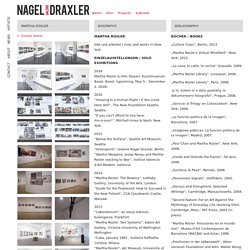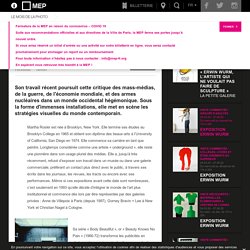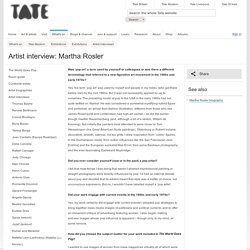

Catalogue de la documentation. La collection en ligne. Martha Rosler - Site web de l'artiste. Martha Rosler - AWARE Archives of women artists. American photographer and video artist.

Martha Rosler is a major international artist whose work has left an indelible mark on the contemporary arts scene. Making use of photomontage, films or installations, her shape-shifting work attest to her desire and policy to create works that shed light on the issues that lie below the surface, such as how we live our lives or how we allow the United States government to speak for us. In 1974, this young political activist was studying at the University of California in San Diego, a place rife with protests and philosophical and aesthetic debates, where she rubbed shoulders with artists such as Allan Kaprow or Miriam Shapiro (1923), and philosophers such as Jean-François Lyotard, who will have an enduring influence on her ideas. Through her work, she adopts scathing and critical positions against the Vietnam war and on feminism.
Martha Rosler – Galerie Nagel Draxler. Lebt und arbeitet / lives and works in New York 2018 Martha Rosler & Hito Steyerl, Kunstmuseum Basel, Basel.

(upcoming, May 5 – December 2, 2018) 2016 “Housing Is a Human Right / If You Lived Here Still”, The New Foundation Seattle, Seattle. “If you can’t afford to live here, mo-o-ove!!” , Mitchell-Innes & Nash, New York. 2015 “Below the Surface”, Seattle Art Museum, Seattle. 2014 “Martha Rosler: The Bowery”, Lethaby Gallery, University of the Arts, London. 2013 “Laboratorium”, w/ Vanja Vukovic, Eulengasse, Frankfurt. 2012 “Meta-Monumental Garage Sale”, Museum of Modern Art, New York. 2011 “In Public”, Galleria Raffaella Cortese, Milano. 2010 “Lesson for Today”, with Josh Neufeld, Side Street Projects, Santa Monica “How Many Billboards?
2009 “Power Games”, Galerie Christian Nagel, Köln. 2008 “Great Power”, Mitchell-Innes & Nash, New York. 2007 “Bringing the War Home”, Worcester Art Museum, MA. Martha Rosler - Galerie Mitchell-Innes & Nash. Lives and works in Brooklyn, NY Brooklyn-based artist Martha Rosler works in video, photography, text, installation, and performance.

Her work often addresses matters of the public sphere and landscapes of everyday life – actual and virtual – especially as they affect women. For many years Rosler has produced works on war and the national security climate, connecting life at home with the conduct of war abroad, in which her photomontage series played a critical part. In 2004 and 2008, in opposition to the wars in Afghanistan and Iraq, she reinstituted her now well-known series of photomontages Bringing the War Home: House Beautiful, made as a response to the war in Vietnam in the late 1960s. Martha Rosler - Maison Européenne de la Photographie. Son travail récent poursuit cette critique des mass-médias, de la guerre, de l'économie mondiale, et des armes nucléaires dans un monde occidental hégémonique.

Sous la forme d'immenses installations, elle met en scène les stratégies visuelles du monde contemporain. Martha Rosler est née à Brooklyn, New York. Elle termine ses études au Brooklyn College en 1965 et obtient son diplôme des beaux-arts à l’University of California, San Diego en 1974. Elle commence sa carrière en tant que peintre. Longtemps considérée comme une artiste « underground », elle reste une pionnière dans son usage pluriel des médias. Martha Rosler: "Semiotics of the Kitchen" (1975) Martha Rosler - Artist interview - Tate Modern. Was ‘pop art’ a term used by yourself or colleagues or was there a different terminology that referred to a new figurative art movement in the 1960s and early 1970s?

Yes, the term ‘pop art’ was used by myself and people in my milieu (who got there before me!) By the mid-1960s. But it was not necessarily applied by us, to ourselves. The prevailing model of pop in the USA in the early 1960s had not quite settled on Warhol. He was considered a somewhat mystifying hybrid figure and performer, an arrival from fashion illustration, different from those who like James Rosenquist and Lichtenstein had high-art cachet – as did the earlier though rowdier Rauschenberg (and, although a bit of a stretch, Willem de Kooning). Did you ever consider yourself (now or in the past) a pop artist? Did your work engage with current events in the 1960s and early 1970s? Yes, my work certainly did engage with current events! How did you choose the subject matter for your work included in The World Goes Pop?